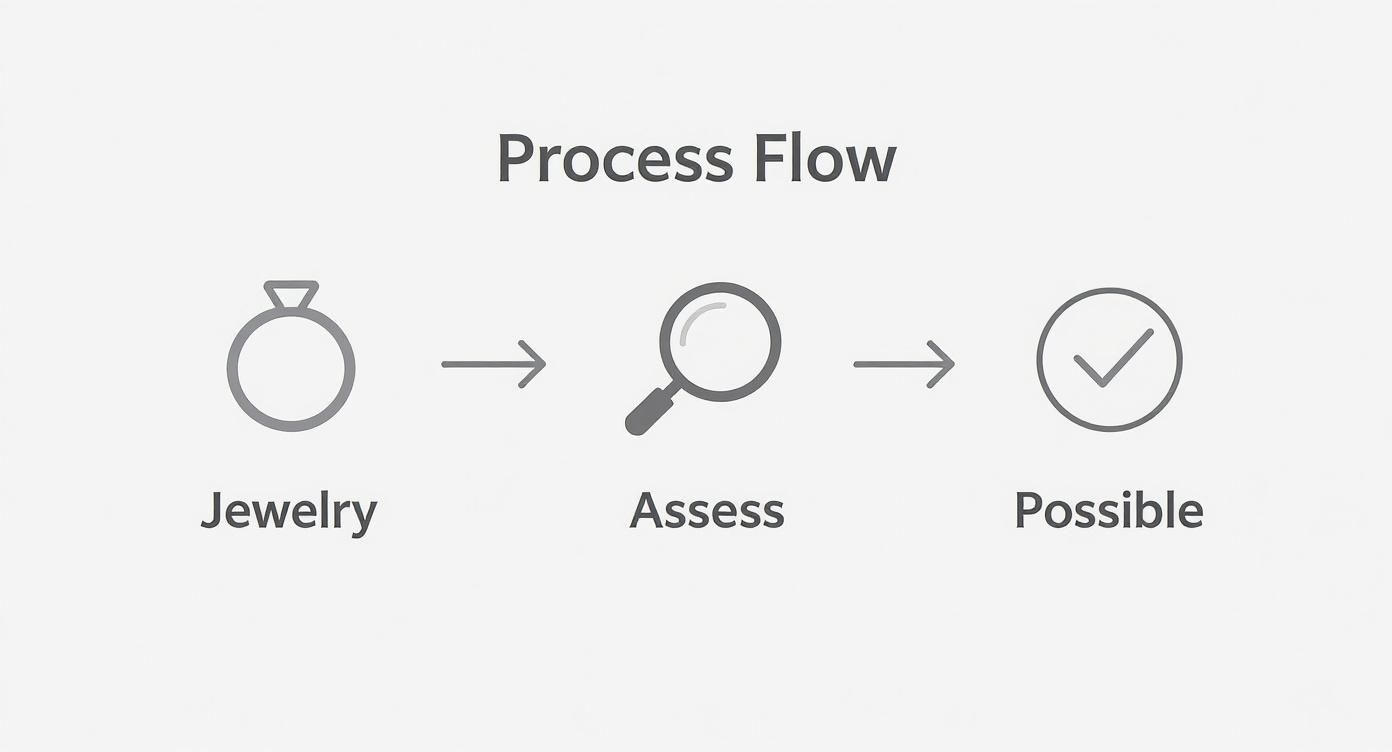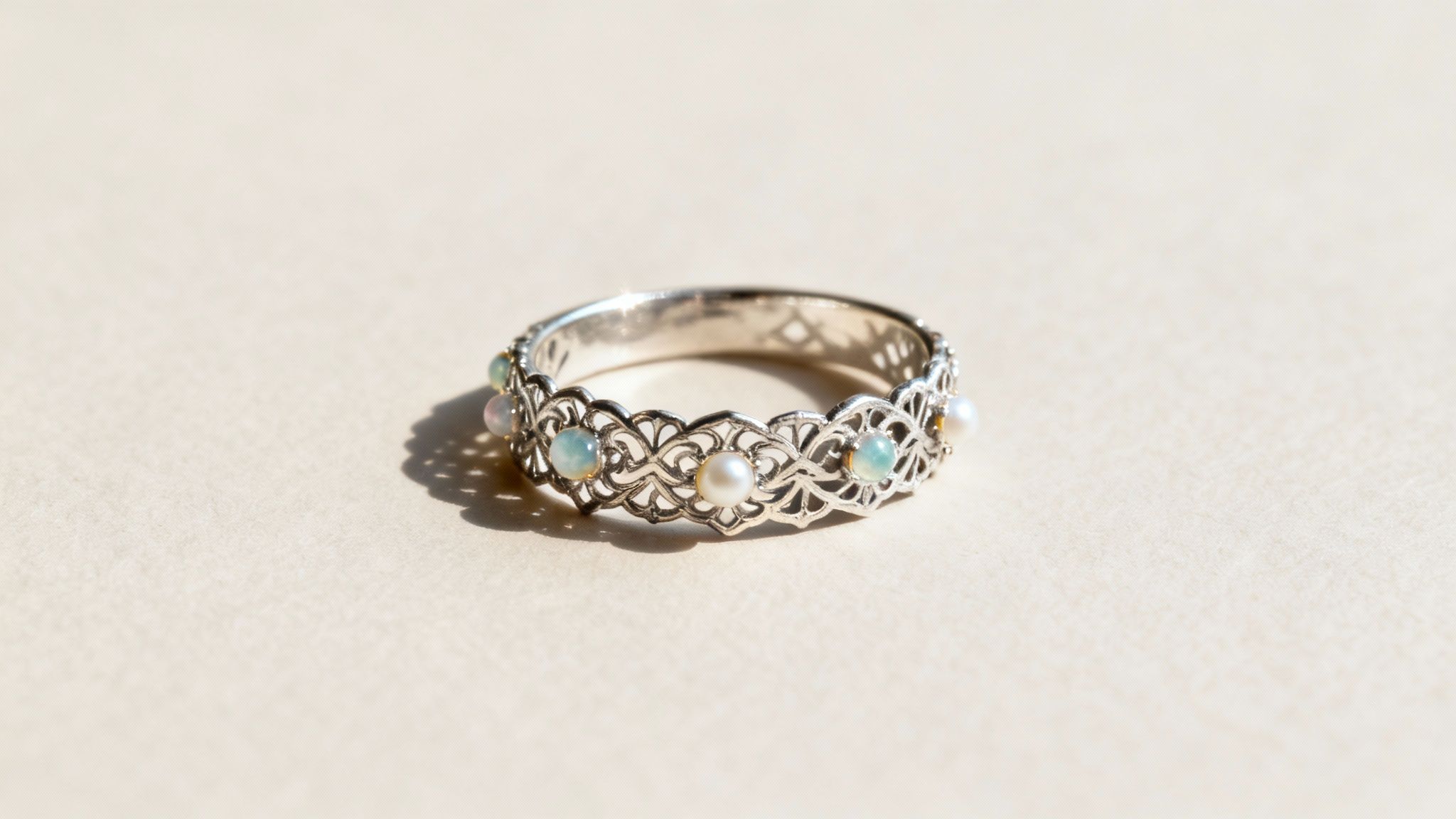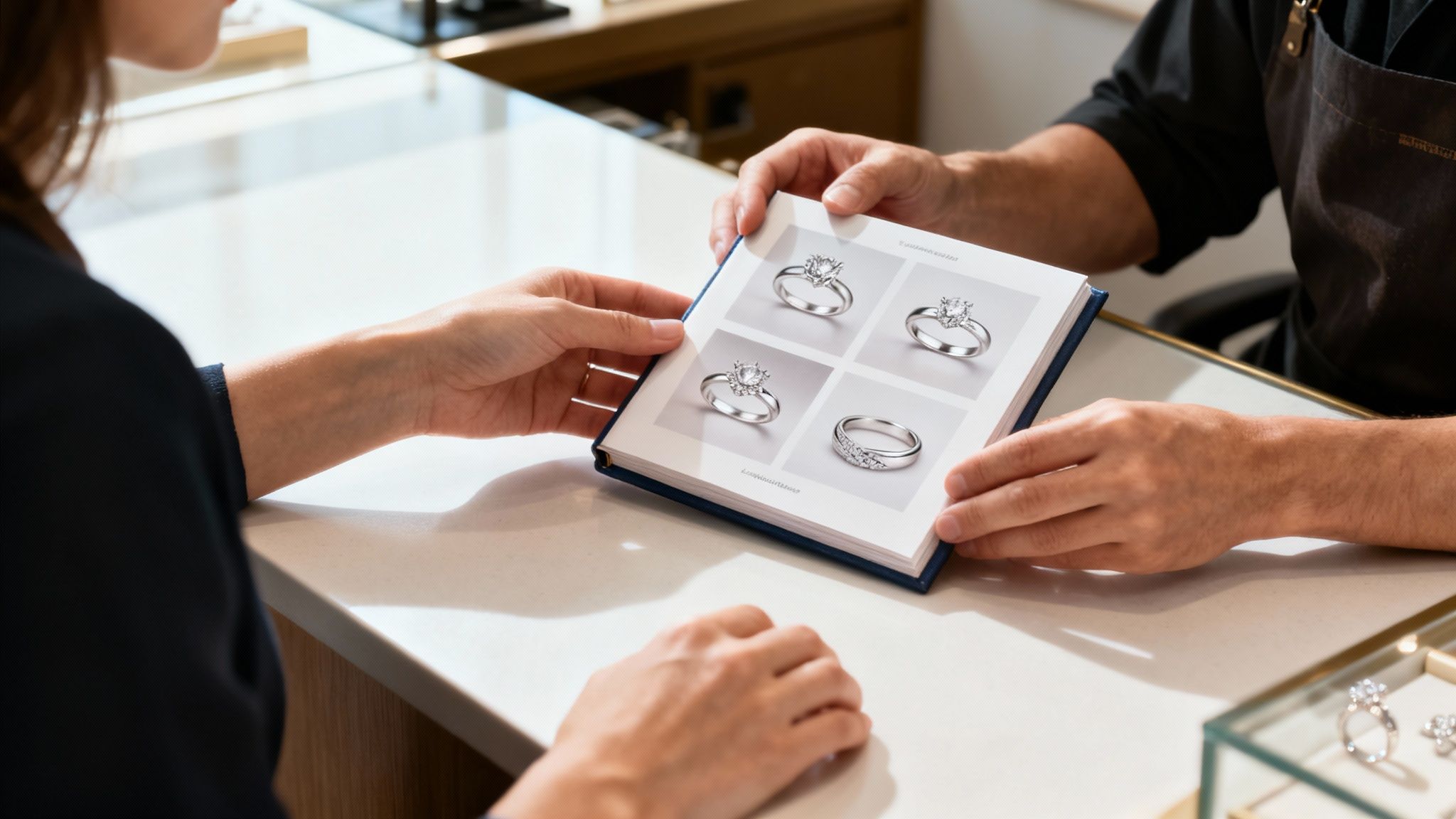can sterling silver be resized: quick guide
- Luke Zucco
- 1 day ago
- 11 min read
Yes, sterling silver can almost always be resized. Its forgiving, workable nature makes it a favorite among jewelers, who can skillfully adjust rings, bracelets, and necklaces to give you that perfect, custom fit.
Understanding Sterling Silver Resizing
So, can you get your sterling silver ring sized up or down? The short answer is yes, but it’s not always a simple snip-and-solder job.
Think of it like getting a favorite piece of clothing tailored. Taking in the waist of a pair of jeans is straightforward, but altering a complex, beaded gown takes a specialist’s touch and comes with a few risks. The same logic applies to your jewelry.
While most sterling silver pieces are great candidates for resizing, a few things can complicate the process:
Intricate Designs: Pieces with continuous patterns, like filigree or eternity bands, are tricky. Resizing can disrupt the design, leaving a noticeable seam or an awkward break in the pattern.
Gemstone Settings: The heat from a jeweler's torch can be a real problem for delicate stones like opals, pearls, or turquoise. A skilled jeweler has ways to protect them, but it adds a layer of difficulty.
Special Finishes: If your piece is plated—like gold vermeil over silver—that plating will be burned off during the soldering process. The entire item will need to be re-plated to restore its original look, adding to the cost and time.
Sterling silver's popularity is no secret. The global market hit a value of USD 11.3 billion in 2023 and is only expected to grow, thanks in large part to our love for adaptable, long-lasting jewelry.
Before you head to the jeweler, it helps to have a good foundation by understanding the properties of sterling silver compared to other metals like gold-plated jewelry. Knowing what makes it so workable will give you a better appreciation for the craft and help you ask the right questions.
Sterling Silver Resizing Feasibility at a Glance
To give you a clearer picture, here’s a quick rundown of how resizable different types of sterling silver jewelry are.
Jewelry Type | Generally Resizable? | Key Considerations |
|---|---|---|
Plain Silver Bands | Yes, very easily | The simplest type to resize, whether going up or down. |
Rings with a Single Stone | Usually | The stone may need to be removed and reset to protect it from heat. |
Eternity Bands | No, or with great difficulty | The continuous stone setting leaves no room to cut and solder without ruining the design. |
Engraved or Patterned Rings | Possible, with limitations | The engraving or pattern will be interrupted at the soldering point. |
Chain Bracelets/Necklaces | Yes | Links can be added or removed to adjust the length easily. |
Bangle Bracelets | Depends on the design | Solid, plain bangles can sometimes be resized; hollow or intricate ones are very difficult. |
This table is a good starting point, but always remember that the final verdict comes down to an expert's in-person evaluation. A good jeweler can work wonders, but even they have their limits based on how a piece was made.
How Jewelers Resize Sterling Silver
Ever wondered what goes on behind the scenes at a jeweler's bench? The process of resizing a ring is a delicate dance of precision, heat, and skilled artistry—almost like a tiny surgical procedure for your most treasured pieces. Whether your sterling silver ring needs to be a bit snugger or a little looser, a good jeweler has a few tricks up their sleeve.
The most common job is making a ring smaller. To do this, a jeweler carefully cuts a small piece out of the shank (the bottom of the band). They then bring the two ends together and seamlessly join them using solder, a special metal alloy designed to melt at a lower temperature than silver. Think of it like a form of high-precision welding, but for precious metals.
Once the solder cools, the ring is meticulously polished until the seam completely vanishes. You'd never even know it was there.
Adjusting Bracelets and Necklaces
Thankfully, resizing sterling silver bracelets and necklaces is usually much more straightforward. For most chain-style pieces, it’s a simple matter of adding or removing a few links to get the perfect length. This is a quick fix that rarely involves heat or soldering, keeping the original design completely intact.
Making a Ring Larger
When a ring needs to go up in size, jewelers have two main approaches. For a small adjustment, typically up to half a size, they can often stretch the existing metal. This involves placing the ring on a specialized tool called a mandrel and applying gentle, even pressure to expand the band.
If you need a more significant size increase, the process is basically the reverse of downsizing. A jeweler will cut the band open and insert a new, perfectly matched piece of sterling silver. They'll then solder it into place on both ends, blending and polishing the new section until it looks like it was part of the ring all along. We dive deeper into this fascinating work in our guide on how they resize rings inside the jewelry resizing process.
Before any of this happens, though, the jeweler has to make a critical assessment. This first look determines if the piece can even be resized safely.

This initial evaluation is by far the most important step. It’s where an expert decides whether the work can be done without compromising the jewelry's design, integrity, or the security of its stones.
Factors That Complicate Silver Resizing

While a simple silver band is usually a straightforward job for any good jeweler, some pieces are another story entirely. Certain designs and materials can turn a routine resize into a high-stakes operation—or make it flat-out impossible.
Understanding these hurdles is key to setting your expectations. It's not that a jeweler doesn't want to help; it's that preserving the beauty of your piece is their top priority.
When The Design Gets In The Way
Sometimes, the very thing that makes a ring stunning is what makes it so tricky to alter. Pieces with continuous, all-around patterns are the most common culprits.
Eternity Bands: These rings have stones set around the entire band. There’s no plain section of metal to cut into, so resizing often means completely rebuilding part of the ring. It’s a massive job that can compromise the original design.
Filigree or Engraved Pieces: Delicate filigree and intricate engravings create a seamless look. Slicing into that band breaks the flow, leaving a visible scar where the pattern no longer lines up.
The uninterrupted beauty of these designs is their signature feature—and unfortunately, it's also their biggest resizing challenge.
Heat, Gemstones, and Plating Don't Mix
Resizing requires a jeweler's torch, and that means intense heat. This is where things get risky for certain materials, especially delicate gemstones.
A jeweler's first rule is to do no harm. If the risk of shattering a stone or melting a finish is too high, they'll almost always recommend against resizing.
Stones like opals, pearls, emeralds, and turquoise are notoriously sensitive. The heat can cause them to crack, cloud up, or permanently change color. A skilled jeweler might be able to remove the stones before working and reset them after, but this adds significant time, cost, and complexity.
Plated jewelry presents another major roadblock. Think of gold vermeil, which is a layer of gold over sterling silver. The heat from soldering will burn that plating right off, leaving a discolored patch.
To fix it, the entire piece has to be stripped and completely re-plated. This process alone can cost more than the resizing itself. So if you're asking, "can sterling silver be resized if it's plated?"—the answer is technically yes, but it’s a much bigger and more expensive project than you might think.
The chart below breaks down some of the most common challenges jewelers face.
Factor | Why It Complicates Resizing | Potential Solution |
|---|---|---|
Eternity Band | No clear metal area to cut; stones are everywhere. | Rebuilding a section of the band; extremely costly and risky. |
Intricate Engraving | Cutting breaks the continuous pattern, creating a visible seam. | A highly skilled jeweler may attempt to re-engrave, but a perfect match is rare. |
Heat-Sensitive Stones | Stones like opal, pearl, or turquoise can crack or discolor from the torch. | Removing stones before work and resetting them after; not always possible. |
Pave or Channel Settings | The heat can loosen the tiny stones, causing them to fall out. | Tightening all stones after resizing, which adds time and labor costs. |
Gold or Rhodium Plating | The plated layer will burn off at the solder joint, causing discoloration. | Stripping and re-plating the entire piece after the resize is complete. |
Hollow Jewelry | Thin, hollow construction can easily collapse or melt under the torch's heat. | Often deemed impossible to resize without destroying the piece. |
Ultimately, every piece is a unique puzzle. A good jeweler will assess all these factors before giving you a confident yes or no.
As our desire for personalized jewelry grows, jewelers are constantly innovating. The global silver jewelry market, valued at USD 40.91 billion in 2024, shows just how much we value pieces that fit our lives perfectly. This demand pushes the industry to find creative solutions for even the most challenging resizing jobs. You can learn more about the growth of the silver jewelry market and consumer preferences in recent industry reports.
Understanding the Cost of Resizing Silver
So, you know your sterling silver piece can be resized. The next question on everyone’s mind is, naturally, "how much is this going to set me back?" The answer isn't a simple flat fee; the price is a direct reflection of the skill, time, and materials your specific piece demands.
Making a ring smaller, for instance, is usually less expensive than making it larger. The logic is pretty straightforward: sizing up requires the jeweler to carefully add a new piece of sterling silver into the band, which means you're paying for both the metal and the labor.
When sizing down, the jeweler removes a small section of the band. In this case, you're primarily paying for their expertise—the precision needed to cut, solder, and polish the ring back to a seamless finish.
When you pay for resizing, you're not just buying a service. You're investing in a craftsman's years of experience, their steady hand, and the risk they take to protect a piece that's important to you.
The biggest factor driving the cost, however, is complexity. A plain, simple band? That’s on the lower end of the price scale. But if your ring has delicate engravings that need to be preserved or stones that have to be carefully removed and reset, the cost will climb accordingly.
Typical Price Ranges
To give you a clearer picture, here are some ballpark estimates for resizing a sterling silver ring. Just remember, these can vary based on your jeweler and location.
Simple Sizing Down: For a plain band with no stones, you can expect to pay somewhere between $25 to $50.
Simple Sizing Up: Making that same plain band a size or two larger will likely run from $40 to $75, factoring in the cost of the added silver.
Complex Sizing: For rings with multiple stones, intricate patterns, or special finishes, the price usually starts around $75 and can easily go over $100.
While getting a ring resized isn't an industrial process, the demand for adaptable, long-lasting jewelry is a huge market force. The growing interest in silver, as detailed in this analysis of the silver market, shows that people value items they can personalize and keep for a lifetime.
The best advice? Always get a firm quote from your jeweler before you commit to any work.
Finding the Right Jeweler for the Job

Handing over a cherished piece of jewelry takes a huge amount of trust. Not every jeweler has the same touch, especially when it comes to the unique personality of sterling silver. Finding the right professional is easily the most important step to ensure your piece is resized beautifully and safely.
You’ll want to start by looking for a craftsman with specific experience in silver. Sterling silver conducts heat completely differently than gold or platinum, a small detail that can make or break a resizing—especially if there are gemstones involved. A jeweler who spends all day working with gold might not have the nuanced skill set needed for silver.
Vetting Your Options
Before you commit, do a little homework. Any reputable jeweler should be completely transparent and happy to answer all of your questions.
Here’s what to look for:
Check Online Reviews: Look for feedback that specifically mentions resizing or repair work. A consistent stream of positive reviews is a great sign of reliability and quality craftsmanship.
Ask to See a Portfolio: Don’t be shy about asking to see examples of their previous resizing work. A confident jeweler will be proud to show you before-and-after photos of their craft.
Inquire About Gemstone Protection: If your piece has stones, ask them to walk you through their exact process for protecting them from the torch’s heat.
A clear, itemized quote is non-negotiable. It should break down the cost of labor, any materials being added, and extra charges for things like resetting a stone or re-plating.
Getting a clear estimate upfront prevents any unwelcome surprises when you go to pick up your piece. As you evaluate jewelers, it's also smart to consider their full range of general jewelry repair services, since resizing is a highly specialized kind of repair.
For a complete overview of the process from start to finish, our guide on how to get a ring resized provides even more detail.
Common Questions About Sterling Silver Resizing
Even with a good grasp of the basics, a few specific questions always pop up when it's time to resize a beloved piece of silver. Getting clear, straightforward answers can make all the difference in feeling confident about your decision. Let's tackle the most common ones.
One of the biggest questions I hear is, "How many times can I actually resize this?" As a general rule, a sterling silver ring can be safely resized two to three times. Each time the metal is heated, cut, and reshaped, it experiences a bit of stress, which can ever-so-slightly weaken its structure. A simple, plain band might be more forgiving, but intricate rings with detailed settings should be altered as little as possible to avoid problems down the line.
Will Resizing Affect My Jewelry's Value?
This is another huge concern, and the answer really depends on the piece. For most contemporary sterling silver jewelry, a professional resizing actually increases its value to you by making it wearable again. A ring that fits is infinitely more valuable than one sitting in a box.
But when it comes to antique, vintage, or certain designer pieces, it gets a little more complex. The real issue is the potential loss of a maker's mark or hallmark. If these stamps are located right where the jeweler needs to cut the band, they could be removed during the process.
A good jeweler knows how crucial these marks are. They'll always do their best to preserve them, understanding that for collectors, these stamps are the key to a piece's history, authenticity, and worth.
Always point out any markings to your jeweler and discuss how they can be protected before any work begins.
Can I Just Do This Myself?
The temptation to try a quick DIY fix is understandable, but when it comes to resizing sterling silver, please don't. Resizing isn't just a matter of bending the metal; it requires specialized tools for precise cutting, soldering with the right temperature and materials, and professional polishing to make the seam invisible.
DIY attempts almost always end badly, leaving you with a misshapen band, an obvious and ugly seam, or even permanent damage to the ring or its stones.
So, how do you get the perfect fit from the very beginning?
Get Sized by a Pro: Nothing beats visiting a jeweler. They have standardized ring sizers that give the most accurate measurement.
Time It Right: Your fingers naturally swell and shrink throughout the day. Try to get measured in the afternoon when your body temperature is stable and your fingers are at their average size.
Avoid Extreme Temps: Don't get measured right after you've come in from the cold or after a workout. Extreme temperatures will throw off the reading and lead to a poor fit.
Wondering how long you'll have to wait? Our guide breaks down the timeline, so check out our post on how long ring resizing takes to help you plan.
At Panther De Luxe Shop, we believe your jewelry should feel like it was made just for you. Explore our collection of beautifully crafted sterling silver pieces designed to last a lifetime. Find your next treasure at https://www.pantherdeluxe.com.

Comments